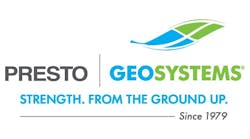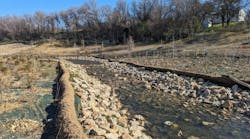To meet federal requirements for flood mapping of levee-protected areas, a levee reconstruction project for the Indianapolis Southport Advanced Wastewater Treatment (AWT) plant was planned along Little Buck Creek. The levee reconstruction was part of the more extensive Deep Rock Tunnel Connector project—one of the largest combined sewer overflow projects for the city of Indianapolis.
To protect the Southport AWT plant and wastewater processing pond from a 500-year flood event from an adjacent creek and river, a vegetated retaining wall system allowed the city to maintain the levee elevation by opening up the creek’s water capacity.
Evaluating the Natural Erosion Protection Solution
The levee embankment along the north side of the wastewater treatment plant had significant toe erosion resulting from flood events and high water flow from the adjacent creek. An erosion protection system to prevent future erosion from the creek’s varying depths and flows was required. Little Buck Creek flows as low as a 1 ft deep with velocities of 3 ft per second (fps) to as much as 8 fps with a depth of 12 to 15 ft during a flooding event.
Project engineer Christopher B. Burke Eng. LLC preferred a wall system that would incorporate native vegetation along the levee with enough sustainability to control erosion from the creek. The Geoweb vegetated wall system chosen would reduce environmental impacts, protect the levee from scour and erosion, and satisfy regulatory requirements.
Construction of the Levee Wall
Designed as a gravity structure without reinforcement, aggregate infill placed in the back cells provides drainage. Filling the open front cells with a blend of topsoil and #2 stone supports vegetation and provides stability and resistance to soil loss during larger storm events.
- Wall face area: 12,000 sq ft; wall length: 1,500 ft; wall heights: 5 to 12 ft.
- Open fascia cells allow storm water infiltration, making Geoweb walls a low-environmental-impact solution.
- Geoweb walls are flexible—they perform well in soft soil environments and conform to the creek’s geometry. The high-density polyethylene material is unaffected by water contact.
- Local supplier D2 Land and Water provided technical and field support to the engineers, contractors and inspectors to ensure an efficient, to-specification installation.
Five-Year Performance Update
The Geoweb wall system with native vegetation proved to be an attractive solution that effectively minimized environmental and permitting impacts.
[Visit Presto Geosystems' SWS Storefront]
Since installation in late 2012, the levee wall performed well during several rain events. Although significantly less expensive than the U.S. Army Corps of Engineers’ (USACE) conventional riprap solution, the USACE are evaluating performance of this green solution for future levee applications.







